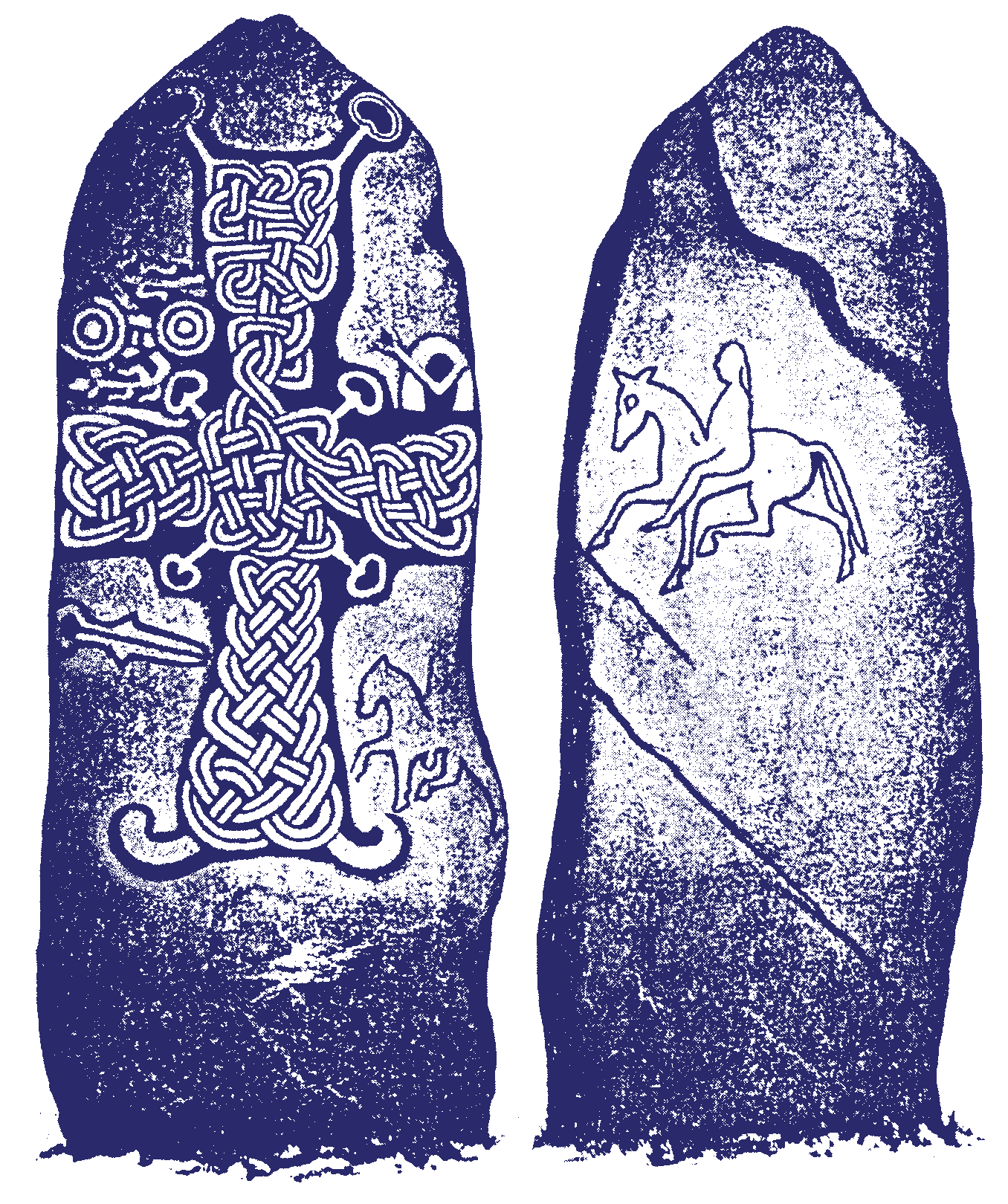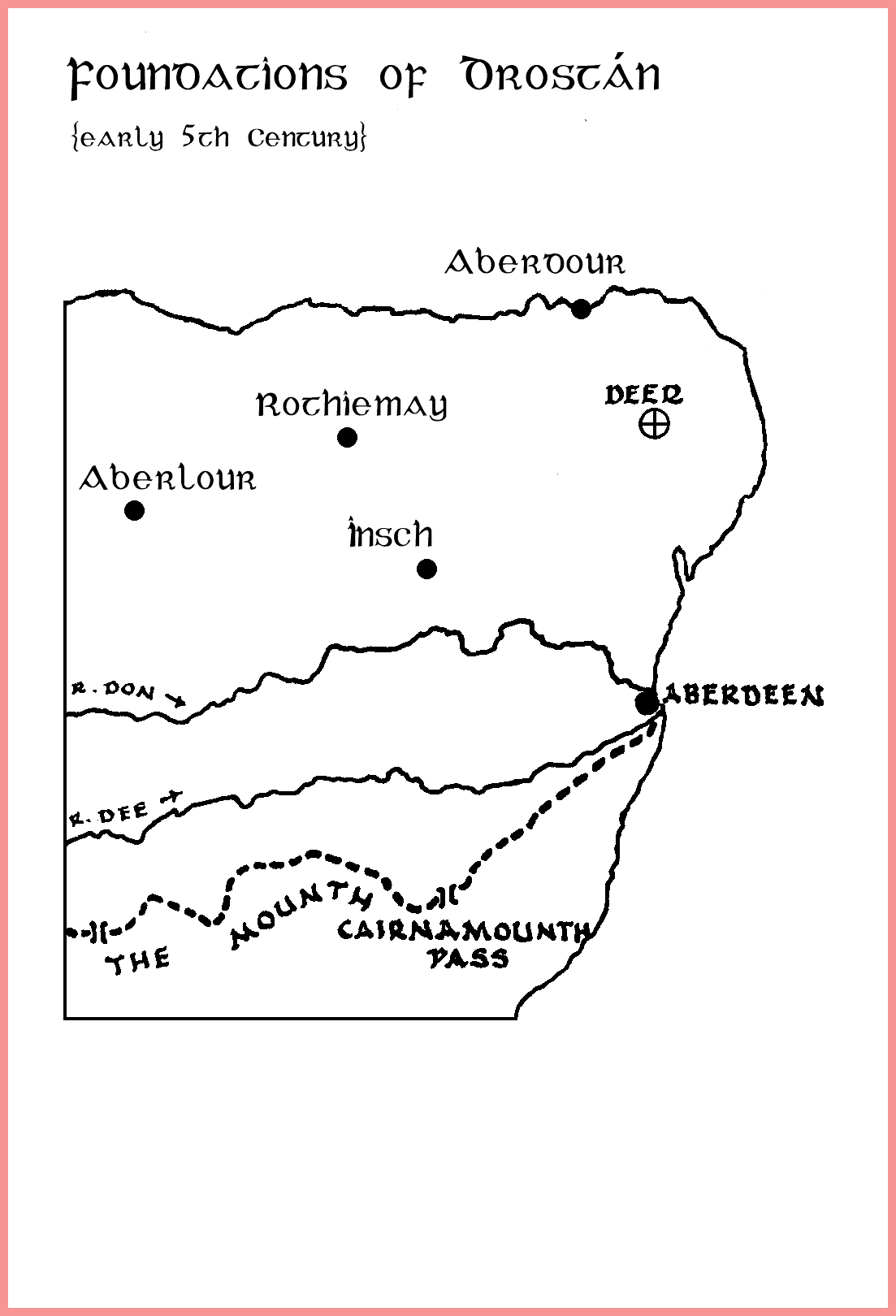Contemporary with St Finbar in the beginning of the sixth century was St Drust, Trust or Drostán mac Coscreig of Deer. {The initial letter of his name in some old documents is T, and in some districts his name is pronounced as if written with initial T.} He is referred to by Oengus the Culdee as "Trustus cona thriur," that is "Drostán with his three" disciples, who were Saints Colm (or Colman), Medan and Fergus.
 Drostán's exact dates have
not been preserved, but his period of activity is clearly
established by certain definite particulars about him. It is
known that he was a Briton, his father being prince of Demetia
(the Demetae), now part of South Wales. Interestingly, the saint
was an elder brother of the mother of Aedhan "the
false". When this Aedhan had proved himslef a military
leader of ability, Colum Cille (St Columba) ordained him king of
the Dalriadic Scots against the wishes of many of the people and
in spite of the rights of Duncan (Donnchadh), son of the previous
king, and in defiance of Scotic law and custom. Aedhan behaved
treacherously towards the Britons, hence the epithet by which he
is known, and he became the steady foe of the Picts of Alba.
Drostán, then, may well have found it best to divorce these
relatives!
Drostán's exact dates have
not been preserved, but his period of activity is clearly
established by certain definite particulars about him. It is
known that he was a Briton, his father being prince of Demetia
(the Demetae), now part of South Wales. Interestingly, the saint
was an elder brother of the mother of Aedhan "the
false". When this Aedhan had proved himslef a military
leader of ability, Colum Cille (St Columba) ordained him king of
the Dalriadic Scots against the wishes of many of the people and
in spite of the rights of Duncan (Donnchadh), son of the previous
king, and in defiance of Scotic law and custom. Aedhan behaved
treacherously towards the Britons, hence the epithet by which he
is known, and he became the steady foe of the Picts of Alba.
Drostán, then, may well have found it best to divorce these
relatives!
So far it has not been possible to determine at which British or Pictish school Drostán was trained. All that is authentic is that "he came off the sea at Aberdour" in northern Aberdeenshire and, after a time, went inland and settled his muinntir at Deer under the sanction of the Pictish mormaor of Buchan, Bede Cruithnech. Bede had at first been hostile to Drostán's settlement but came to accept his presence it time. The Buchan authorities give Drostán's dates as c.AD 500, whilst the date of his fellow missionary, St Fergus, is given as "the beginning of the sixth age," c.AD 520.
The influence of the missionary centre at Deer was enormous and it may be argued that with these workers, Christianity became firmly established across the north-east. Not only was this influence felt on the southern shores of the Moray Firth but, no doubt from Aberdour, ships carried Drostán's influence to Caithness. Deer was, without doubt, one of the most important centres of Christian missionary work in Europe at the time, to compare with ease with any other. It is to be hoped that its greatest literary legacy, the Bok of Deer, a gospel-book of the 10th century now in Cambridge University Library, may find its way back to its native homeland one day.
.gif)
Aberdour Bay - where Drostán landed.
Drostán has been the victim of one of the more fanciful "histories" handed down in the Aberdeen Breviary. He is said to have been a nephew of St Columba, who trained him. The fact that his name is obviously Britonic or Welsh makes this difficult to accept and the fact that Drostán's major work seems to have taken place in the early years of the sixth-century (Columba did not come to Hy (Iona) until AD 563) makes it virtually impossible to believe. The Book of Deer contains a famous legend inserted into its margins in an eleventh-century Gaidhealic hand, whereby St Colm is boldly transformed into St Columba and this has led to the incorrect assumption that Columba was with Drostán when he founded Deer. Colum Cille, to say the least, would have been a very unwelcome visitor in these parts and would have been of little use in the missionary work since he spoke a tongue which was not understood by the Picts. No, Drostán was not Columba's man, he was his own.
.gif)
The medieval church of Aberdour built over the remains of Drostán's foundation.
The number of church sites dedicated to this group of saints will give the reader an impression of how important their influence was on the Taizaloi and Ce tribes of the north-east.

But of course Deer's influence was felt over more distant areas both to the west in the lush green expanses of the Spey valley and beside dark Loch Ness, and to the misty lands of northern Caithness. There was also the "sister" foundation of the monastery at Turriff which was an acknowledged seat of learning for many years in the days of the Celtic Church.
One cannot underestimate the importance of the work of "the men of Deer." They were responsible for spreading the word of Christ amongst the peoples of the north-east who had first heard it from St Ninian at his muinntir of Methlick. They developed a surer foundation for the faith whose existence may have been something which the Picts tolerated rather than believed in. With Drostán, the faith became more secure, more a part of life for the previously polytheistic peoples of Buchan.
.gif)
Remains of the Cistercian Abbey of Deer.
Notes.
e-mail: admin@cushnieent.force9.co.uk
© 2005 Cushnie Enterprises